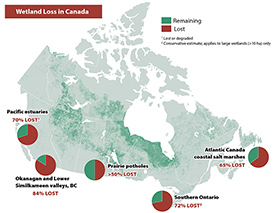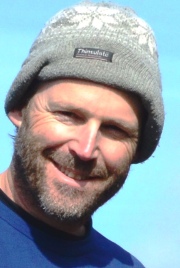A world without wetlands
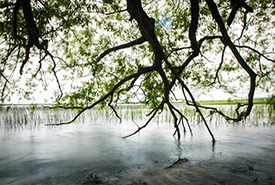
Brighton Wetland, Eastern Lake Ontario Coast (Photo by David Coulson)
I live next to a swamp. After 20 years of having this swamp as my neighbour, it’s kind of grown on me. I enjoy the spring flush of marsh marigolds, the annual reawakening of spring peepers, and I still smile when I see a colourful wood duck perched in a tree.
That said, it’s not a particularly special swamp. Like many swamps where I live in southern Ontario, it’s wet enough to keep maple and beech at bay, but not so wet that cedar, soft maple and balsam fir can’t grow. One small area is so wet that no trees grow at all, and it’s filled with dogwood and cattails.
My swamp has two sources that keep it wet. There’s water that seeps from the ground. That water starts as rain and snow in the surrounding hills and journeys through sand and rock before emerging in springs. My swamp also stores water from snowmelt and heavy summer rains that drain into these lowlands. All wetlands are wetlands because they are permanently or seasonally wet, and that changes the types of plants that grow there.
There was a time when almost nobody liked swamps, or any other type of wetland. Wetlands have a long history of being seen as wastelands. Places to be avoided. Places to be filled or drained.
My swamp probably survived because it was too difficult to drain. It’s part of a much larger swamp, and the land is not well suited for crops. This wetland is fortunate because, here in Canada and around the world, most wetlands are in trouble.
It’s estimated that 64 per cent of the world’s wetlands have disappeared since 1900[1]. In the last 50 years, our planet’s inland and coastal wetlands have declined by over one-third (where data is available) — a rate three times greater than the loss of forests[2]. While the loss of wetlands has recently slowed in Europe, it has accelerated in Asia[3]. In the U.S., states like California, Ohio, New York and Idaho have lost over half of their wetlands[4].
Canada’s northern hinterlands hold a huge majority of the world’s remaining wetlands. The Hudson Bay Lowlands and Mackenzie Basin are some of the largest areas of wetland left on Earth[5]. Collectively, Canada’s wetlands represent almost one quarter of the wetlands remaining on the planet[6]. These northern wetlands are important for Canada, but also for the world. They provide breeding habitat for millions of waterfowl, they are a global motherlode of carbon storage, and they represent one of a few dwindling places on our planet where wetlands are still wilderness.
But our wetlands in southern Canada reflect the fate of wetlands around the world. It’s been estimated that by 1990, 49.9 million acres (20 million hectares) of Canada’s wetlands had been lost[6]. Wetlands associated with urban areas are particularly threatened, with 80 to 98 per cent converted to other uses[6]. But almost everywhere Canadians live, most of the original wetlands have been lost (see map).
Wetland Loss in Canada
Location
- Okanagan and Lower Similkameen Valleys, BC[8]
- Southern Ontario*[9]
- Atlantic Canada coastal salt marshes[6]
- Prairie potholes[6]
- Pacific estuaries**[6]
* The extent and loss trends provided only apply to large wetlands (>10 ha) and are therefore a conservative estimate of wetland loss.
** Lost or degraded.
Canadians have done a good job conserving some wetlands. Canada has designated 37 sites as Wetlands of International Importance[7]. Many are protected in national parks, ranging from Lake Erie marshes at Point Pelee to the massive Peace-Athabasca Delta in Wood Buffalo. We are continuing to add to our portfolio of protected wetlands and build new wetland conservation partnerships. In 2018, the Nature Conservancy of Canada and Ducks Unlimited Canada announced the protection of 230 acres (93 hectares) of the Brighton Wetland on Lake Ontario, with support from the Government of Canada, through the Natural Areas Conservation Program, Municipality of Brighton, Lower Trent Region Conservation Authority, Northumberland Land Trust, Lone Pine Land Trust as well as nature clubs and many individual donors.
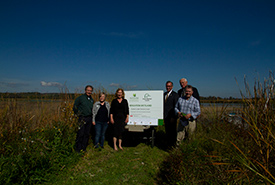
Brighton Wetland announcement, Brighton, ON (Photo by NCC)
But despite our collective conservation efforts, we are still losing wetlands. Not only are we continuing to see them disappear under roads, cities and farms, but even wetlands that are protected are increasingly threatened. Invasive species such as European common reed and glossy buckthorn are degrading many of the wetlands we have left in southern Canada. Black ash, a still common tree found in many swamps, was recently assessed as a threatened species in Canada because of the predicted impact of the invasive emerald ash borer.
To conserve wetlands we need to think bigger than wetlands. Many species that live in wetlands also depend on the surrounding uplands. Spring peepers move into forests after they are done spring peeping. At our place, a wood duck nests in a big old beech tree and then marches her young to the swamp. The water that comes and goes from wetlands impacts the broader watershed, and that watershed impacts the wetlands. The connections of wetlands to surrounding lands and waters is diverse and deep.
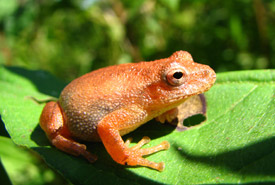
Spring peeper (Photo by Ryan M. Bolton)
World Wetlands Day is an opportunity to reflect on our wetlands. I don’t need to look any further than my swamp to appreciate the critical role that wetlands play, for nature and for people. In addition to habitat for marsh marigolds, spring peepers and wood ducks, it also supports hundreds of other wildlife species. I’d never drain my swamp because I like plants and birds and that sort of thing, and would deeply miss them. My swamp also qualifies under the Ontario Conservation Land Tax Incentive Program, which exempts the wetland portion of my property from taxes. But beyond ecology and economy, I feel a certain civic pride and duty about this place. Fill my swamp and another wild space disappears. Fill my swamp and I add the millions of gallons of water that it holds to my neighbour’s property and beyond. This impact would cascade to farmers and communities downstream.
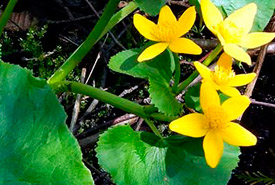
Marsh marigold (Photo by NCC)
Wetlands in and around cities and farms might be some the hardest working ecosystems on the planet. They help clean water, prevent floods and protect wildlife. They have done this for centuries. Left intact, they will continue to do so for centuries to come.
There’s much more we can do to protect wetlands. Canada’s national wetland inventory needs to be completed. Key wetland areas need to be identified, protected and restored. All private landowners should be rewarded for protecting wetlands, and not given incentives to drain them. We need management plans that prevent invasive species and plan for the health of our watersheds. Perhaps most importantly, we need a new appreciation of what wetlands provide to us.
I don’t want my children to grow up in a diminished natural world. In a world without wetlands, there is no opportunity to hear spring peepers calling and no memories of marsh marigolds. In a world without wetlands, the jobs and costs of flood control and water purification are downloaded from nature to people.
There will never be a better time to protect Canada's wetlands than there is today. As our human population grows, while wildlife populations decline, and as we each bear witness to rapid planetary changes that will forever affect the lives of future generations, Canada and the world needs our wetlands more than ever.
References
- Ramsar Convention on Wetlands, Wetlands: a global disappearing act. 2017.
- Ramsar Convention on Wetlands, Global Wetland Outlook: State of the World’s Wetlands and their Services to People. 2018, Ramsar Convention Secretariat: Gland, Switzerland.
- Davidson, N.C., How much wetland has the world lost? Long-term and recent trends in global wetland area. Marine Freshwater Research, 2014. 65(10): p. 934-941.
- Dahl, T.E., Wetlands losses in the United States, 1780's to 1980's. Report to the Congress. 1990, U.S. Department of the Interior & Fish and Wildlife Service: Washington D.C. p. 13.
- Keddy, P.A., et al., Wet and Wonderful: The World's Largest Wetlands Are Conservation Priorities. BioScience, 2009. 59(1): p. 39-51.
- Environment Canada, The federal policy on wetland conservation. 1991, Minister of Supply and Services: Ottawa, ON. p. 14.
- Ramsar Convention Secretariat. Country profiles: Canada. 2014 [cited 2019 January]; Available from: https://www.ramsar.org/wetland/canada.
- Lea, T., Historical (pre-settlement) ecosystems of the Okanagan Valley and Lower Similkameen Valley of British Columbia–pre-European contact to the present. Davidsonia, 2008. 19(1): p. 3-36.
- Ducks Unlimited Canada, Southern Ontario Wetland Conversion Analysis. 2010.

